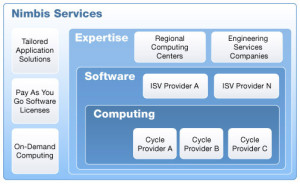At the height of the first wave of the commercial cloud computing boom, around 2008, two HPC industry figures, Brian Schott and Robert Graybill, put their heads together to see how clouds might support high performance computing workloads. Their efforts led them to develop a “clearinghouse” for cloud-based HPC platforms and applications, which in turn prompted them to bundle, price, and support variations on these packages for companies and HPC centers to use along software as a service (SaaS) or platform as a service (PaaS) lines.
Offering a service like Nimbis was novel at the time, especially for complex environments in government and manufacturing where licensing, regulation, data access and collaboration, and multiple other challenges exist. Further, while the Amazons of the world were busy building their own marketplaces, these were heavy on Web 2.0-driven applications but not robust or specific enough for many HPC workloads. Even with the eventual addition of HPC-oriented instance types and GPU accelerated nodes for rent on Amazon’s boxes, the ecosystem for high performance computing, particularly for government lab and agency users (and smaller to medium-sized manufacturers), remained underdeveloped.
Graybill noted that government adoption was slow at first, but has since exploded, particularly in terms of private clouds—but also now in public cloud environments following more recent development from a number of cloud service providers. For example, despite the application and workflow support holes for HPC, Amazon did set about to solve some of the challenges of the regulatory environment on its own through its GovCloud program (which certifies the underlying hardware and virtualization).
Elsewhere, Graybill points to significant investments in validating OpenStack and efforts from other cloud providers, including Microsoft with its Azure public cloud, bolstered the cloud possibilities for the types of customers Nimbis Services hoped to reach. He was especially enthusiastic about the future of OpenStack, noting that such an effort to level the playing field, provide access and support across clouds, and provide a stable, validated basis for the types of applications they work with would have taken many millions to develop without such a robust community of supporters and contributors (of which Nimbis is one). Even with such development at AWS, with OpenStack, and Azure, he says there are still a number of technical hurdles, including license management, complex workflow design for cloud-based applications, and the support of secure environments among a defined pool of users. It is in these critical areas that Nimbis hopes to continue pushing its services.
Graybill told us this week that the company has gone into a silent “stealth mode” of sorts over the last year to prepare for a newer generation of cloud-based applications for government and manufacturing as the needs are changing in the wake of wider cloud adoption in both areas. Government makes up nearly 75% of the small company’s revenue, with the remainder devoted to manufacturing. Graybill says their emphasis going forward is to flip those two numbers, putting the emphasis on manufacturing and other areas, including EDA and a wider set of commercial market segments. The company’s Blue Collar Computing offerings as well as those around Wolfram tools are robust, but they’re looking to new horizons following some new contracts. For instance, Nimbis Services has been awarded a 2-year contract by the Air Force Nuclear Weapons Center to develop a “Trusted Silicon Stratus” that will allow the DoD and its contractors to conduct EDA in the cloud.
This deal in particular highlights how services like those from Nimbis are still highly relevant now that the use of cloud computing for complex workloads isn’t exactly new. His company not only manages the partner ecosystem for the EDA tools required for a security-conscious and regulation-bound entity, they also handle other aspects related to management, validation and compliance. For instance, Nimbis is able to monitor and guide the entire workflow to ensure they have full checks over the entire heritage of the data—the history of how it was used, collaborated upon, co-developed across sites and users—virtually everything from the time the data was first loaded into the cloud until chip fabrication. Further, license management, one of the great unsung villains of cloud computing use (especially for the highly expensive application areas like EDA), is managed through Nimbis, leaving users with more options beyond a long procurement for a license or worse, a year-long license when only a few short months might be needed.
 As Nimbis says, the advantage is that anyone with a credit card (or approved purchase order) can shop their technical computing marketplace of fully integrated HPC platforms and modeling and simulation applications and purchase on-demand metered usage of these products “without the large investment of procuring, integrating, and maintaining these products separately and the long delays of negotiating license and service agreements.”
As Nimbis says, the advantage is that anyone with a credit card (or approved purchase order) can shop their technical computing marketplace of fully integrated HPC platforms and modeling and simulation applications and purchase on-demand metered usage of these products “without the large investment of procuring, integrating, and maintaining these products separately and the long delays of negotiating license and service agreements.”
This is especially relevant for manufacturing, which can, according to Graybill, use the service to affordably explore and use HPC-level modeling, simulation, and analysis for virtual prototyping with help from domain-knowledgeable experts if needed. “We have broken down the barriers to HPC adoption for the small to medium sized enterprises in the engineering and manufacturing supply chain,” the company says.
Nimbis is a technology partner for many existing government and manufacturing projects, including the Ohio Supercomputer Center’s (OSC) Blue Collar Computing program, the grid portal for the National Center for Manufacturing Sciences, and offers support for cloud-based Wolfram, ANSYS, Abaqus and other modeling and simulation tools. They are also partners for the UI Labs and DoD Digital Manufacturing and Design Innovation Institute and the AweSim program at OSC, in addition to other programs nationwide.
Aside from growing its manufacturing and commercial sector growth in 2014, Graybill says that Nimbis will continue expanding its partner ecosystem, which will open doors to new application areas and a healthier selection of ISV offerings for users outside of government to choose from.





























































